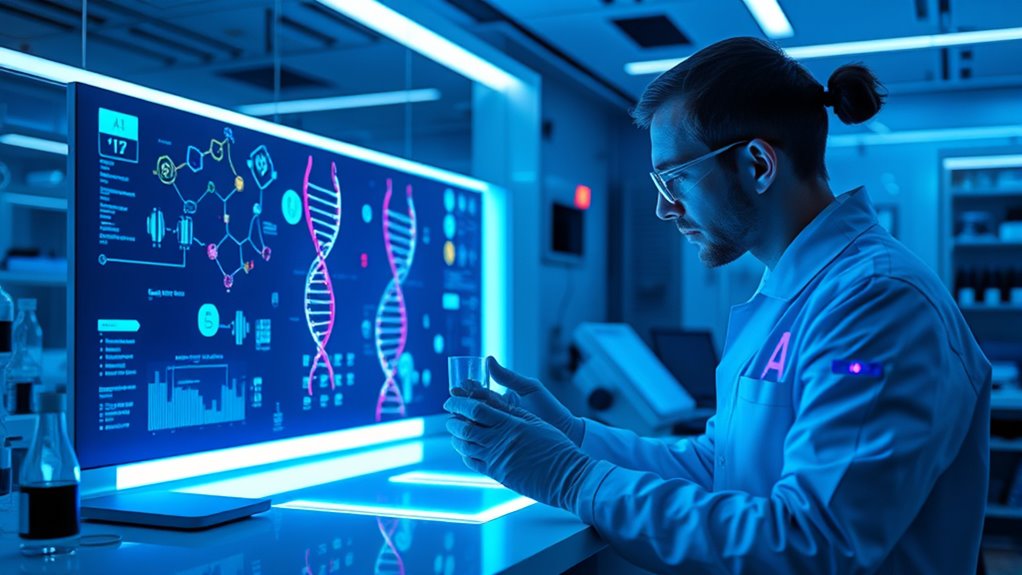Bioinformatics meets AI-driven drug discovery accelerates how you analyze biological data. By integrating AI with genomic, proteomic, and clinical information, you can identify new drug targets, understand disease pathways, and predict treatment responses more efficiently. AI automates complex data interpretation, revealing patterns that traditional methods might miss. This synergy shortens drug development timelines and enhances personalized therapies. Continue exploring, and you’ll discover how these innovations are shaping the future of medical research and treatment.
Key Takeaways
- AI enhances genomic data analysis, enabling faster identification of drug targets and therapeutic pathways.
- Machine learning automates interpretation of genetic variants, improving accuracy in disease association predictions.
- Integrating multi-omics data uncovers complex biological interactions, revealing novel drug candidates.
- AI-driven models prioritize drug candidates based on genetic profiles and patient responses.
- Continuous AI advancements streamline drug discovery, supporting personalized medicine and innovative therapies.

Bioinformatics has revolutionized how we comprehend biological data, but when combined with AI-driven techniques, it accelerates drug discovery like never before. Imagine diving into vast amounts of genomic data to uncover hidden patterns that could lead to breakthrough treatments. That’s where genomic analysis plays a vital role. By examining DNA sequences, gene expression profiles, and mutations, you can identify potential targets for new drugs more efficiently. Traditional methods often involve hours of manual interpretation, but with advanced machine learning algorithms, you can automate this process, rapidly sifting through massive datasets to find meaningful signals. These algorithms learn from known data, recognizing complex patterns that might elude human analysis. For instance, supervised learning models can classify genetic variants based on their likelihood of causing disease, streamlining the identification of promising drug targets. The integration of AI accelerates the discovery process, reducing time-to-market for new therapies.
You harness the power of machine learning algorithms to enhance your genomic analysis, making predictions about biological functions or disease associations with high accuracy. These models don’t just analyze data—they adapt and improve as they process more information. This means your insights become increasingly precise over time, reducing false positives and focusing your efforts on the most promising candidates. Whether you’re working with sequence alignment, variant calling, or gene expression data, machine learning helps you interpret the biological significance of your findings faster than traditional statistical methods.
Furthermore, these algorithms can integrate multiple data types—such as genomic, proteomic, and clinical data—to create extensive models of disease pathways. This holistic view enables you to understand the complex interactions within biological systems, revealing novel therapeutic targets that were previously hidden. By leveraging AI-driven genomic analysis, you gain a strategic advantage: you can prioritize drug candidates based on their genetic profiles, predict how patients might respond to treatments, and personalize therapies accordingly. Additionally, advancements in AI integration in bioinformatics are paving the way for more precise and efficient drug discovery pipelines.
Frequently Asked Questions
How Does AI Improve the Accuracy of Drug Target Identification?
AI, especially machine learning, improves drug target identification by analyzing vast datasets quickly and accurately. It helps you discover potential targets by spotting patterns that might be missed manually. AI also enhances target validation, ensuring your identified targets are relevant and effective. This speeds up the process, reduces errors, and increases confidence in your choices, making your drug discovery efforts more precise and efficient.
What Challenges Exist in Integrating Bioinformatics With AI Algorithms?
You might think integrating bioinformatics with AI algorithms is simple, but it’s ironic how complex data integration and algorithm intricacies actually pose major hurdles. You face challenges in harmonizing diverse datasets and managing algorithm complexity, which often slows progress. Despite AI’s promise, these obstacles remind you that merging biological data with advanced algorithms requires patience, precision, and innovative solutions—it’s not as seamless as it seems.
Can AI Predict Long-Term Drug Efficacy and Safety?
You wonder if AI can predict long-term drug efficacy and safety. While AI utilizes predictive modeling to forecast outcomes, its accuracy depends on extensive data and rigorous long-term validation. AI shows promise, but it can’t yet fully replace clinical trials for confirming safety over time. You should view AI as a valuable tool that complements traditional methods, helping to identify potential issues early and guide more targeted long-term studies.
How Accessible Are Ai-Driven Bioinformatics Tools to Researchers?
You might wonder how accessible AI-driven bioinformatics tools are to researchers. Open source platforms have substantially improved data accessibility, allowing more scientists to access powerful algorithms and datasets without high costs. These platforms foster collaboration and innovation, making it easier for researchers to utilize AI tools for drug discovery and bioinformatics tasks. As a result, the barrier to entry decreases, enabling broader participation and accelerating scientific progress.
What Ethical Considerations Arise From AI in Drug Discovery?
When exploring AI in drug discovery, you should consider ethical issues like data privacy, ensuring patient information stays protected. You also need to address algorithmic bias, which can lead to unfair or inaccurate results. By actively managing these concerns, you help create trustworthy AI systems. It is crucial to implement strict privacy measures and regularly audit algorithms to prevent bias, fostering responsible innovation in the field.
Conclusion
As you embrace this fusion of bioinformatics and AI, remember that you’re shaping the future of medicine—like the pioneers of the Renaissance, but with a laptop instead of a quill. This synergy accelerates drug discovery, saving lives and ending disease. Keep pushing boundaries, because in this brave new world, every breakthrough is a testament to your innovation. The journey may seem like a leap of faith, but with AI, you’re rewriting the story of healing itself.









